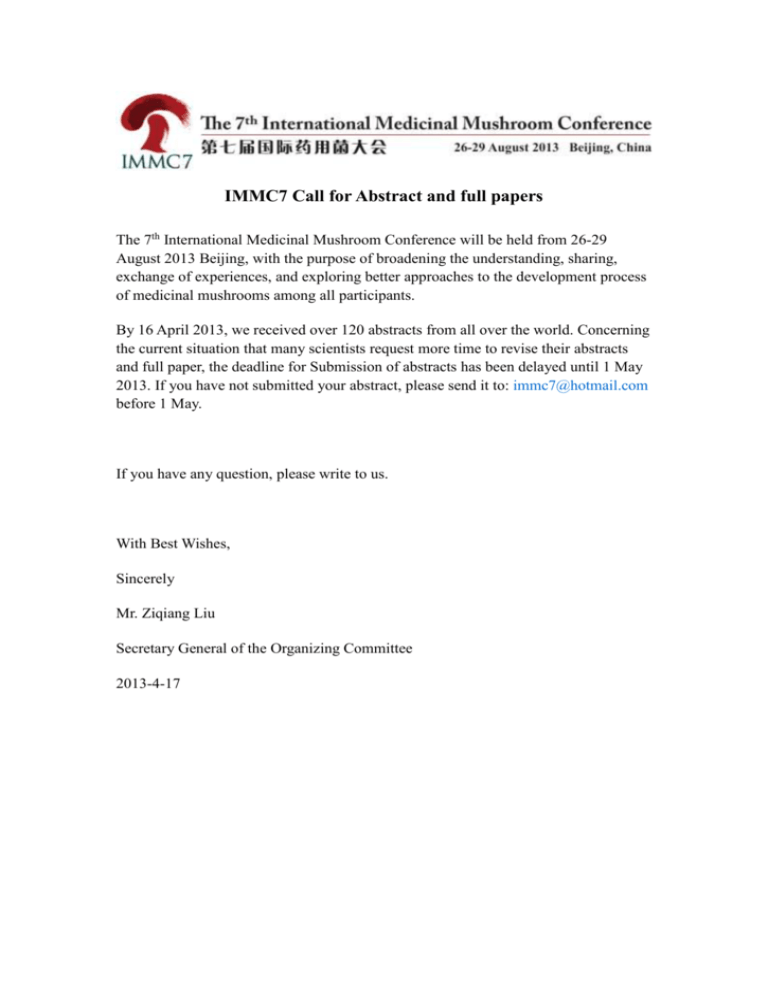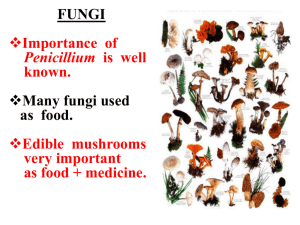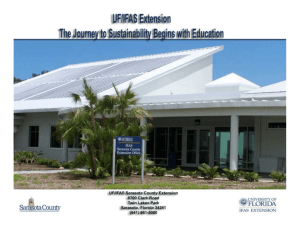Call for Abstract and full papers - The 7th International Medicinal
advertisement

IMMC7 Call for Abstract and full papers The 7th International Medicinal Mushroom Conference will be held from 26-29 August 2013 Beijing, with the purpose of broadening the understanding, sharing, exchange of experiences, and exploring better approaches to the development process of medicinal mushrooms among all participants. By 16 April 2013, we received over 120 abstracts from all over the world. Concerning the current situation that many scientists request more time to revise their abstracts and full paper, the deadline for Submission of abstracts has been delayed until 1 May 2013. If you have not submitted your abstract, please send it to: immc7@hotmail.com before 1 May. If you have any question, please write to us. With Best Wishes, Sincerely Mr. Ziqiang Liu Secretary General of the Organizing Committee 2013-4-17 Call for papers Abstract We invite contributions that pertain to the conference topics from interested authors. Abstracts should focus on current issues relevant to scientific progress and/or to industry, and should have scientific and/or technical content. Abstracts should clearly define the objectives of the presentation, topics covered, key conclusions reached, and potential benefits for scientific developments and for industry. At least 500 words are required for each abstract. The abstracts will be accumulated into a book of abstracts, which will be printed and distributed to the participants at the meeting. Additionally, an electronic version of the Abstract Book will be available at the symposium’s web page. The electronic version must be prepared in Microsoft Word in Windows format and in the required IMMC7 2013 abstract form (download from www.immc7.com). It should be sent as an attached file by e-mail before 1 May 2013 to: immc7@hotmail.com Full paper Some excellent papers of IMMC7 will be published in the International Journal of Medicinal Mushrooms (IJMM). Please send the full paper according to journal format of the IJMM before June 6, 2013 if the IMMC7 Secretary informs you of your abstract acceptance. If you have any question about academic, please send E-mail to immc7@hotmail.com. Sample of abstract GENETIC MANIPULATION TECHNOLOGY COULD MAKE THE MUSHROOMS FROM NUTRICEUTICALS TO PHARMACEUTICALS R. S. Hseu1, C. T. Huang1, C. Y. Kuo2, S. Y. Chou2 and C. C. Chang2 1 Department of Biochemical Science and Technology, Institute of Microbiology and Biochemistry, National Taiwan University, Taipei, Chinese Taipei; 2MycoMagic Biotechnology Limited Company, Taipei, Chinese Taipei. E-mail: rshseu@ntu.edu.tw The gene transformation plays a key role in the modern biotechnology. Heterologous genes can be expressed in various organisms ranged from microorganisms, plants and animals. Molecular pharming, using transgenic plants, animals or higher microorganisms to produce recombinant proteins with pharmaceutical or commercial potential, will have a great impact on the agricultural biotechnology in the future. Molecular pharming could be used to produce bioplastics, industrial enzymes, vaccines, antibodies, and other pharmaceuticals. The major advantage of molecular pharming is the ability to produce recombinant proteins at large scale with economical expense. The cost is cut down tremendously in comparison with the traditional process.﹒﹒﹒﹒﹒ Full paper Some excellent papers of IMMC7 will be published in the International Journal of Medicinal Mushrooms (IJMM). Please send the full paper according to the sample format before March 31, 2013. Sample of full paper Medicinal Mushroom Products: Nutriceuticals and/or Pharmaceuticals? S. T. CHANG Emeritus Professor of Biology, The Chinese University of Hong Kong, Shatin, N. T. Hong Kong SAR, China. Email: scha6507@bigpong.net.au (Address all correspondence to S. T. Chang, 3 Britton Place, McKellar, A.C.T. 2617 Australia). Abstract: Although the effectiveness of mushroom products (mushroom derivatives) has been confirmed repeatedly by numerous laboratory experiments and, .﹒﹒﹒﹒﹒ Key words: mushroom product, nutriceutical, pharmaceutical, traditional Chinese medicine 1 Introduction First of all, it may be interesting to have a charming mushroom poem as a beginning to this article: “WITHOUT LEAVES, WITHOUT BUDS, WITHOUT FLOWERS, YET, .﹒﹒﹒﹒﹒ Pharmaceuticals/Drugs As a medicine As a tonic Traditional medicine/ Nutriceuticals As a food Functional food/ Figure 1. Nutraceuticals Pyramid model for the mushroom industry The above pyramid model of the mushroom industry conforms fully to an old Chinese saying, “Medicines and food have a common origin”. This statement is particularly applicable .﹒﹒﹒﹒ ﹒ 2 Mushrooms as a Food There is increasing experimentally-based evidence to support centuries of observations regarding the nutritional (and medicinal benefits) of mushrooms. Mushrooms .﹒﹒﹒﹒﹒ Table 1 Proximate composition of three mushroom species[3] A. bisporus L. edodes Pleurotus spp Moisture 78.3-90.5 90.0-91.8 73.7-90.8 Crude protein 23.9-34.8 13.4-17.5 10.5-30.4 1.7-8.0 4.9-8.0 1.6-2.2 Total carbohydrate 51.3-62.5 67.5-78.0 57.6-81.8 N-free carbohydrate 44.0-53.5 59.5-70.7 48.9-74.3 Total dietary fibre 8.0-10.4 7.3-8.0 7.5-8.7 Ash 7.7-12.0 3.7-7.0 6.1-9.8 Energy value 328-368 387-392 345-367 Component Crude fat All data are presented as percentage of dry weight, except moisture (percentage of fresh weight) and energy value (Kcal per 100 g dry weight). 8 Concluding Remarks Medicinal mushroom-derived products are neither nutraceuticals (food/functional food) nor pharmaceuticals (drugs), because the active ingredient of most products is not a single, chemically defined compound as used in conventional drug treatments. Therefore, they may be classified as a type of nutriceutical or as a dietary supplement or traditional medicine which is a category between food and drugs. .﹒﹒﹒﹒﹒ References [1] Chang ST, Miles PG. Edible Mushrooms and Their Cultivation. 1989, CRC Press, Boca Raton (FL). [2] Xue CC, O’Brien KA. Modalities of Chinese medicine. In: Leung PC, Xue CC and Cheng YC (eds), Comprehensive Guide to Chinese Medicine. World Scientific, Singapore, 2003, 19-46.











